Looking for detailed insights about the Dallas Cowboys players, coaches, and philosophies?
This chapter from Warren Sharp’s ‘2020 Football Preview' book gets you prepared for the NFL season by delivering the smartest information & analysis in the fastest, most direct way possible.

Jason Garrett had 10 years as head coach of the Dallas Cowboys. But it’s been 24 years since the Cowboys won a Super Bowl and in that span, they haven’t even made it past the Divisional round once. “America’s Team” has made the Divisional round just six times in those 24 years and are 0-6 when there.
They’ve gone through a number of well-known coaches in that span, including Barry Switzer, Bill Parcells, and Wade Phillips. All of them outperformed Jason Garrett if success is measured on winning seasons. Each of Switzer, Parcells, and Phillips coached in Dallas for four seasons and each produced winning records in three of those four seasons.
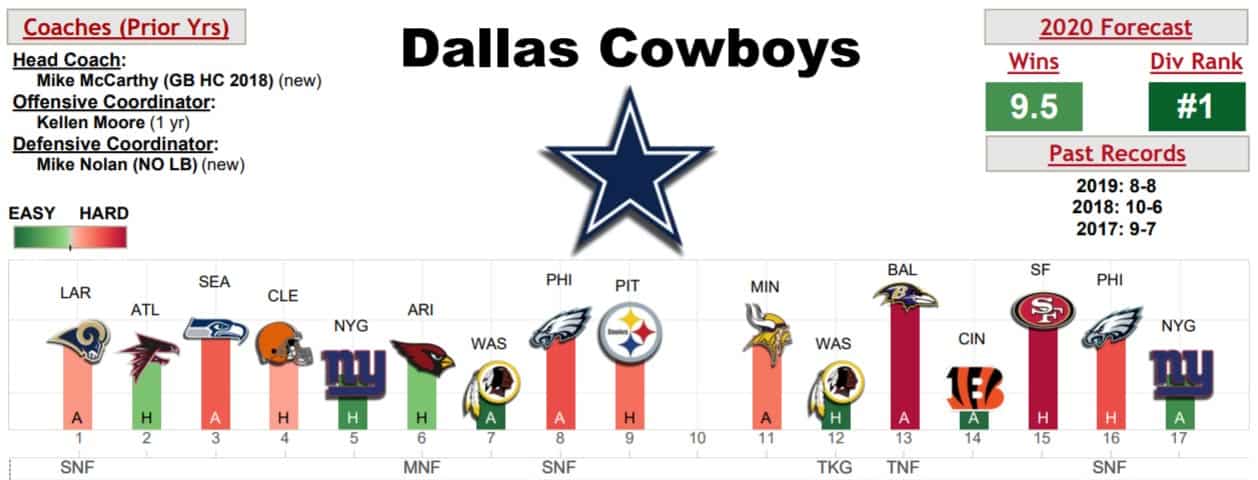
Jason Garrett got over twice the seasons as full-time head coach. In his nine seasons, he produced winning records in just four of nine seasons. His tenure started with three straight non-winning 8-8 seasons. And yet somehow, Jerry Jones kept Garrett around much longer than Switzer, Parcells, or Phillips.
The team is now in Mike McCarthy’s hands, and it is a very good team, particularly on offense. The problem has been the Cowboys have never seemed to be a great team. And although oftentimes good teams can go on great runs, the Cowboys never seemed to put it all together to make such a run.
Take the 2019 Cowboys. They sat at 6-4 through 11 weeks in an NFC East that was well below average last season. The division was effectively theirs for the taking. But they dropped three consecutive games to fall to 6-7. A dominant win over the Rams in Week 15 meant that if the Cowboys won their final two games of the season, they would still win the NFC East and make the playoffs at 9-7. But they lost to the Eagles in Week 16 and were knocked out of the playoffs with an Eagles win against the Giants in Week 17.
That fast 3-0 start was never capitalized upon. But the hype the 3-0 Cowboys received was exceptional.
For the complete Dallas Cowboys chapter, including a dozen more visuals & info-graphics, Defensive breakdown and detailed Fantasy football implication — plus the other 31 team chapters — pick up a copy of Warren Sharp’s new ‘2020 Football Preview’ book and use the coupon code “BOOK10” to take $10 off at purchase.
The first stop would be to look at the betting market. Immediately prior to the season, the Cowboys were +160 to win the NFC East while the Eagles were -160. The Cowboys beat the Giants 35-17 in Week 1 and their odds dropped to +125. In Week 2, the Cowboys beat the Redskins 31-21 while the Eagles lost and suddenly Dallas was favored to win the NFC East at -125. Another win, this time 31-6 over the Dolphins, coupled with another Eagles loss and suddenly the Cowboys were -300 to win the NFC East.
They moved from +160 to -300 simply from beating the Giants, Redskins, and Dolphins while the Eagles dropped two games by less than seven total points. Cowboys fans were on top of the world.
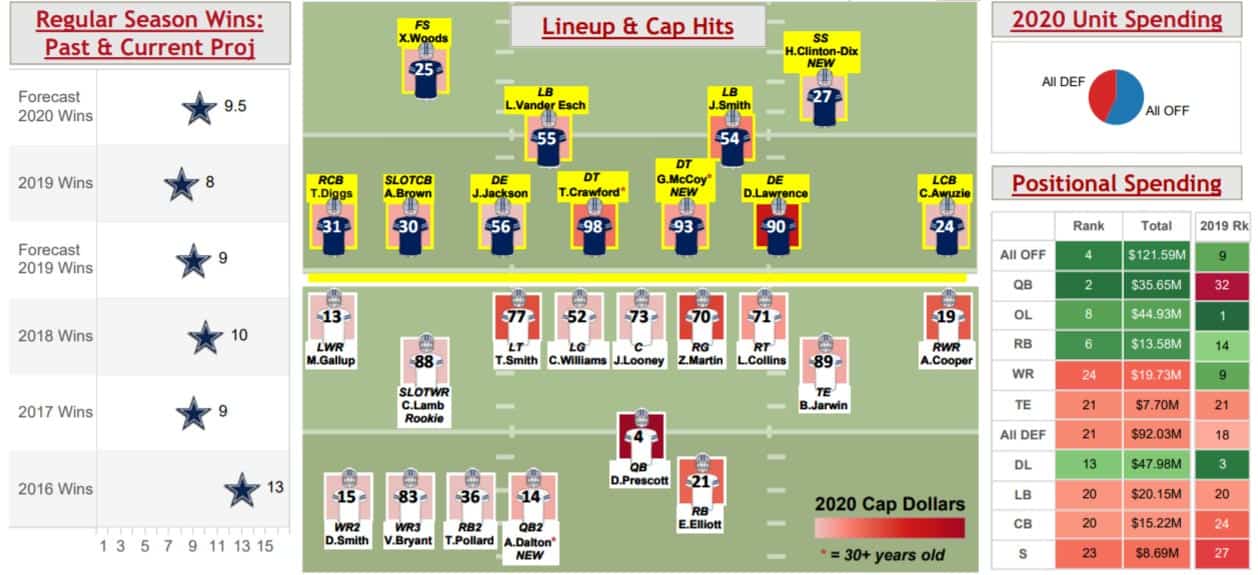
And so was the analytics community with respect to something new 2019 playcaller Kellen Moore pulled out: play-action.
The Cowboys weren’t bad with play-action in 2018 — they used it at an average rate of 22% of all passes (NFL average was 23%) and on 37% of early down passes in the first half (NFL average was 34%).
But Dallas didn’t need play-action. On those early downs in the first half, Dak Prescott was actually slightly more efficient (whether using EPA, success rate, or passer rating) when passing without play-action. But the one thing play-action did was lower his sack rate tremendously, from 10.7% without play-action to 1.2% with play action.
But in 2019, the analytics community was buzzing after Week 2’s game against the Redskins with how Kellen Moore was using play-action.
He used it on 41% of attempts in Week 1 and 39% of attempts in Week 2. Dallas’s 40% play-action usage rate through two weeks was the most in the NFL (average was 23%).
Not only was the rate well above both the Cowboys 2018 average under Garrett and the NFL’s 2019 average, but the key was the depth of target (aDOT) and results of these play-action passes.
In 2018, Dallas had an aDOT of 7.4 yards on play-action, which was well below league average (8.6 yards). But in 2019, these targets had a whopping 11.5 aDOT through Week 2. The league average was only 8.2 yards, but Prescott was well above that average. Deeper passes should be more difficult to complete, but Prescott recorded a perfect 158.3 passer rating on these play-action passes.
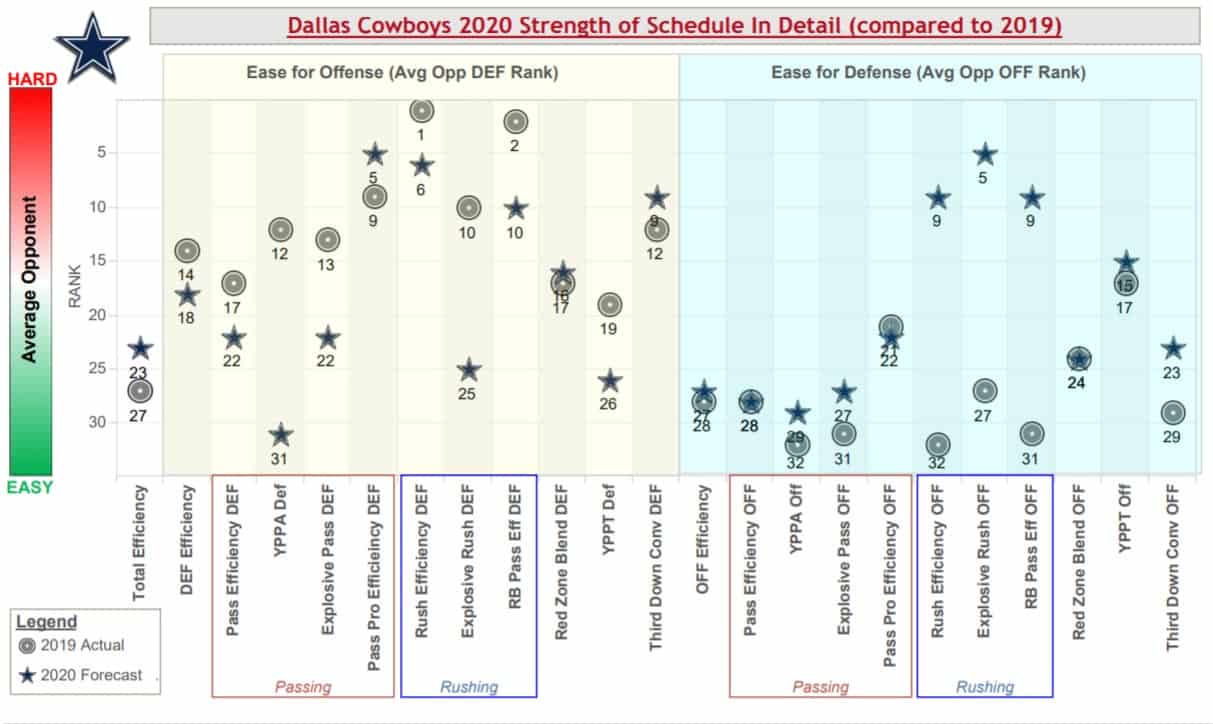
With the Cowboys killing the Dolphins 31-6 in Week 3, they didn’t need to use play-action as often, but their aDOT was 15.5 yards when they did use a play fake.
But then, sitting at 3-0, something strange happened.
In Weeks 4 through 6, the Dallas usage of play-action and aDOT when using play-action revered back to 2018 numbers.
In those three games, Dallas used play-action on only 18% of pass attempts, and their aDOT dropped to 9.1 yards.
After three games and 11 attempts with 17+ air yards off play-action, the Cowboys had three such attempts in the next three games.
After three games with six attempts over 25 air yards off play-action, the Cowboys had zero such attempts in the next three games.
Dallas lost all three games and fell to 3-3 on the season.
Such a pattern continued all season long. Teams used play-action on 24% of passes in 2019.
When the Cowboys used play-action at least at the league average, they went 8-2.
When the Cowboys used play-action less than the league average, they went 0-6.
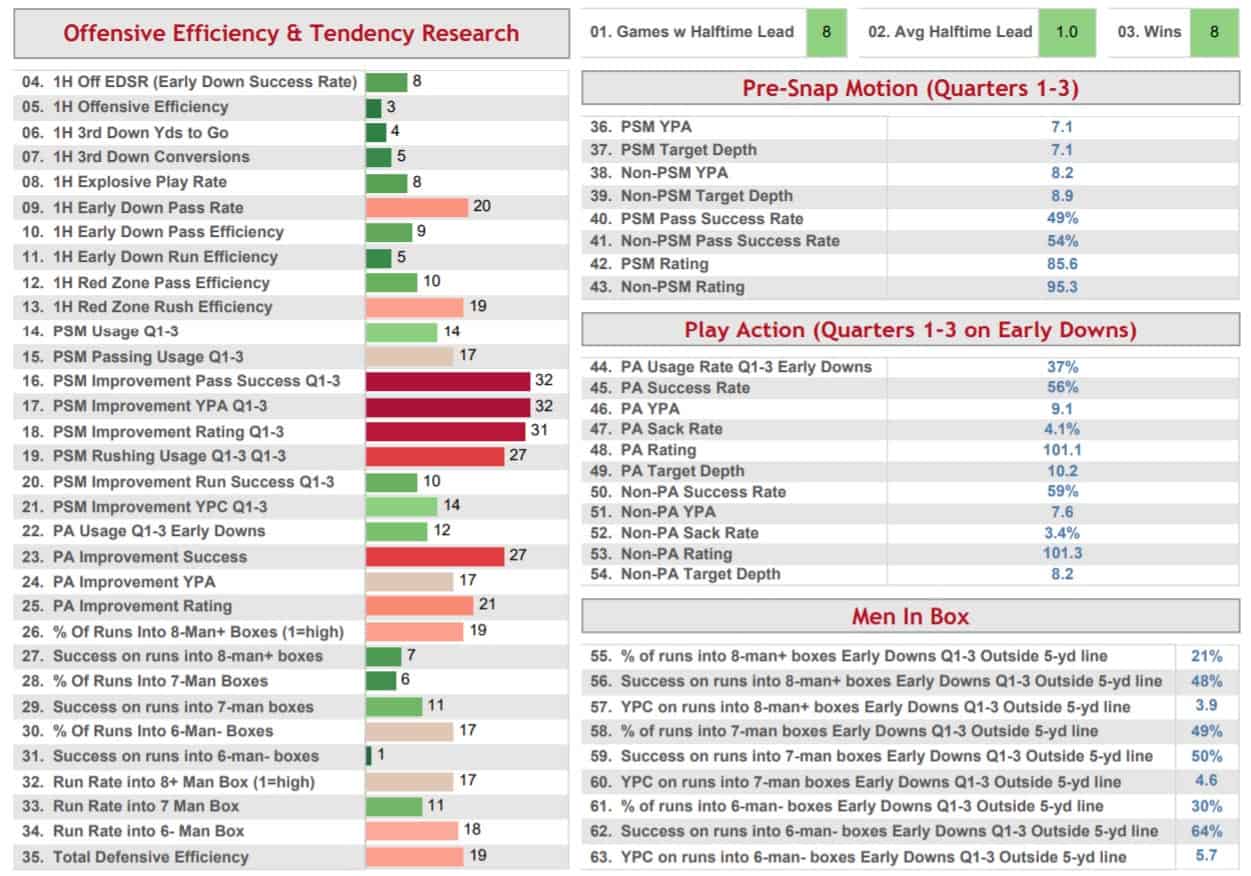
The only losses when using higher rates of play-action were against the Vikings (four-point loss and lost the turnover battle) and the Patriots (four-point loss and lost the turnover battle).
Using more play-action won’t ensure wins, but it was something that worked early and then was reduced quite randomly.
Dallas went 1-6 in games decided by one-score, so apart from a blowout loss to the Packers, there wasn’t a situation where Dallas should believe they were down so much that the defense wouldn’t respect play-action.
Another frustrating element of the Cowboys’ 2019 offense was something that continued from prior seasons, and that was an inability to get production out of Ezekiel Elliott in the passing game. Dallas was deadly when targeting wide receivers (third-best in the NFL) and tight ends (fourth-best in the NFL) but when targeting backs, they ranked 20th, with well below average EPA and success. A similar story was true in 2018, when Dallas was above average to wide receivers and tight ends but ranked 29th to running backs.
The initial inclination might be to believe these are dump off passes to prevent sacks and we should expect a lower success. But that wasn’t the case.
In 2019, 31% of all running back targets came when the quarterback was under pressure, and the other 69% came when the quarterback was not pressured. Elliott received exactly 69% of his targets when Prescott was not pressured, identical to the NFL average.
The problem also wasn’t give-up targets for field position on third-and-long either. Only 85% of Elliott’s targets were not on third down.
League wide, EPA, success rate, YPA, and passer rating on throws to running backs are all better when the quarterback was not pressured. The problem for Dallas was all the metrics listed above were equal to or worse for Elliott when Prescott was not pressured as they were when he was under pressure.
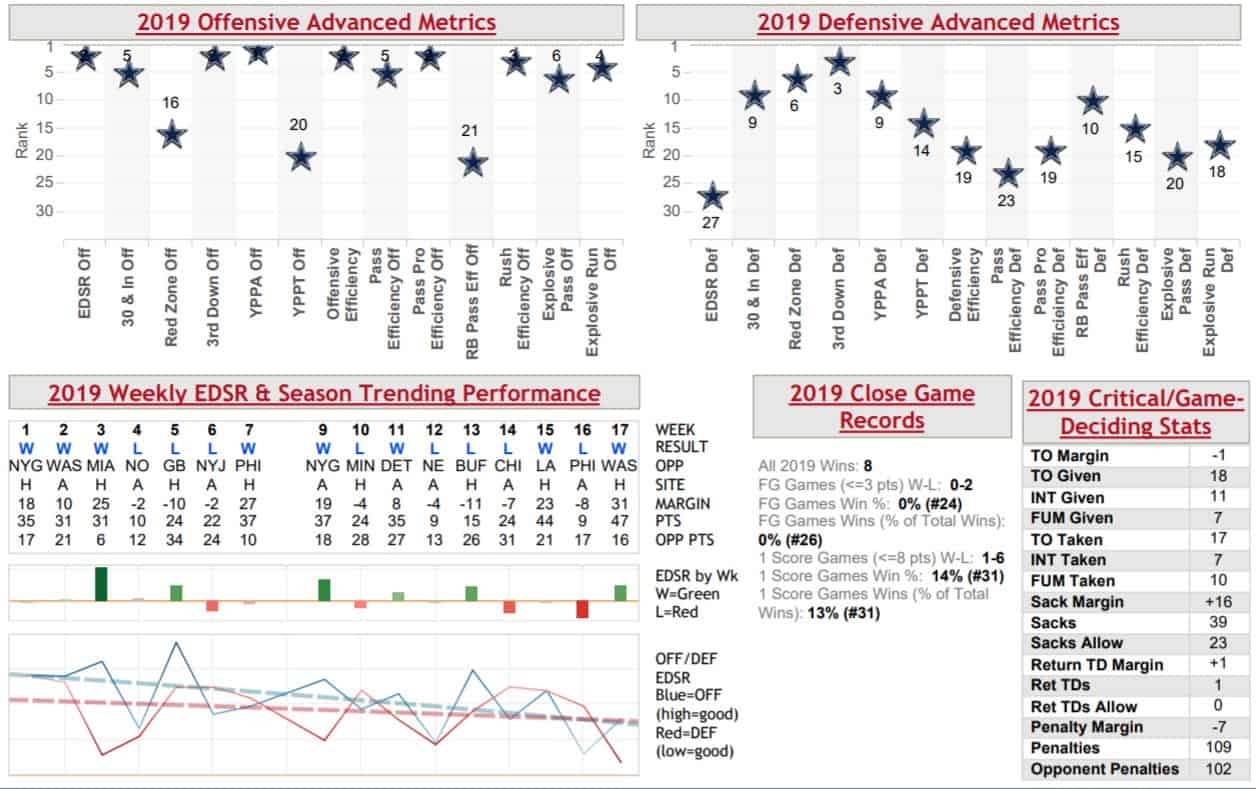
Removing third downs, most of Elliott’s targets were on screen passes. Elliott was targeted on four types of passes more than five times on non-pressured early downs (screens, curls, flats, and swing routes). He didn’t eclipse 40% success on targets from any of those four routes save for screens. Meanwhile, the NFL average was at least 50% success on all four of those routes.
This simply comes down to play design for running back targets. Well over half of Elliott’s targets came from 11 personnel last year (expected, as 11 was the preferred offense for Dallas). League-wide, non-third down running back targets typically have a solid floor (53% success, 99.3 rating, 6.5 YPA) but not quite as much upside as running back targets from 12. But Elliott was down at 41% success, 82.5 rating, and 4.5 YPA.
Dallas is getting tremendous production when targeting wide receivers and tight ends. They cannot afford to waste production on running back targets when those play designs come with a floor so much lower than other targets.
Another important adjustment for the Cowboys would come in their playcalling deep in the red zone. In 2019, they ranked 16th in red zone conversion rate. In 2018 they ranked 27th. And yet in those two years, they have used their most successful rusher the least of any player.
When inside the 10-yard line over the last two years, the Cowboys have 61 rushing attempts on early downs. Of the 61, 14 went to Dak Prescott while 46 went to Ezekiel Elliott. Prescott recorded a 64% success rate while Elliott recorded just a 39% success rate.
Of 37 players with at least 14 rushing attempts inside the 10, Prescott ranked 10th while Elliott ranked 30th in success rate. Dallas absolutely should allow Prescott the benefit of more designed runs. And similarly, they need to refine the way they use Elliott. He has a nose for the end zone, recording a 72% success rate on all carries inside the two-yard line. But from the three-yard line to the 10-yard line, only 30% of Elliott’s 40 attempts the last two yards were successful. That success rate ranks dead last in the NFL out of 30 running backs with at least 15 attempts.
One interesting nugget is that the 2019 Cowboys defense played the easiest schedule of opposing rushing offenses. But in 2020, they are projected to face the NFL’s ninth-toughest schedule of run offenses. Last year, they played seven teams with rushing attacks that ranked 17th or better. They went 1-6 in those games (and 7-2 in the rest of their games). In 2020 they are projected to face eight teams with above-average run offenses.
A great step for the Cowboys last year was Prescott’s depth of target. In 2018, Prescott ranked 37th in third-downs thrown short of the sticks, 9% below average. He improved to second in 2019, ranking 6% above average. And when comparing air yards to YAC, Prescott improved from 27th (51% of yardage being before the catch) to fifth in 2019 (63% of yardage being before the catch). This was strong growth by Prescott and a more aggressive scheme under Moore.
Last spring I predicted the 2019 Cowboys would face the tenth-easiest schedule. They actually played the sixth-easiest schedule. This year, I’m forecasting another cushy schedule, the ninth-easiest overall. And over the first seven weeks, it’s the third-easiest in the NFL.
I conducted a 10-year study on NFL schedule inequality, the likes of which had never been performed before. I spoke with several people on different team staffs and team management positions who said they have never seen a study at that depth of detail previously. And they were shocked by the results. I also know that people in league offices were surprised to see the results of the study, and how some teams were favored to such an extreme while others were put at such a disadvantage.
In the NFC East, the Cowboys were the third-most benefited team, while their three in-division rivals all were bottom-10, and the Giants and Eagles were both bottom-three.
Digging into the nuances of the 2020 schedule, the Cowboys play in five primetime games plus their annual Thanksgiving game. On the positive: their two “short-week” games (one off of Monday Night Football and one being a Thursday game) somehow both are against the lowly Redskins. While they play in Baltimore for a road Thursday night game, they have a full week of prep because the schedule makers put that game the week after Thanksgiving. Late in the season, they get to host the division-rival Eagles on Sunday night.
Dallas Cowboys 2019 Passing Recap & 2020 Outlook
The Cowboys passing game was stellar in 2019 on the strength of a career season for Dak Prescott, who set career marks with 4,902 yards and 30 passing touchdowns. Dallas ranked second in the league in success rate on passing plays (53%) while leading the league in average yards per passing play (6.5 yards) a year ago. Jason Garrett has been replaced by Mike McCarthy as head coach, but offensive coordinator Kellen Moore was retained by the new regime to keep some continuity intact in rolling over some of their 2019 passing success.
2019 Receiving Recap & 2020 Outlook
The Cowboys’ wide receivers were among the league’s best in 2019, ranking second in receiving yardage per game (217.2 yards), second in average yards per target (9.7), and third in success rate per target (57%). Bringing Amari Cooper back on a long-term extension, with Michael Gallup entering his third season and adding CeeDee Lamb via the draft this season, Dallas arguably has the best wide receiver trio in the league entering the year. Cooper was third in the NFL in success rate per target (63%) for all wide receivers with at least 50 targets on the season. At tight end, the team ranked fourth in the league in success rate targeting their tight ends (62%). The team let Jason Witten and his 83 targets walk in free agency which will give Blake Jarwin a full runway in 2020. If there is one area where the Dallas passing game can improve, it is by getting more production out of their backfield after ranking 20th in success rate in targets to running backs (43%).
2019 Rushing Recap & 2020 Outlook
Dallas was once again among the league’s best rushing teams in the league in 2019, averaging 4.8 yards per rushing play (second) with a 55% success rate (second). Both Ezekiel Elliott (55.8%) and Tony Pollard (52.3%) were well above the average success rate (47.7%) on the ground. Elliott has ranked top-five in the league in rushing yards per game in each of his first four seasons in the league. Pollard proved to be a great compliment as a rookie, averaging 5.6 yards per touch and leading all running backs with 50 or more carries on the season in rate of runs to gain six or more yards (38%). Even with the retirement of Travis Frederick, Dallas has one of the league’s best offensive lines and best rushing attacks.

For the complete Dallas Cowboys chapter, including a dozen more visuals & info-graphics, Defensive breakdown and detailed Fantasy football implication — plus the other 31 team chapters — pick up a copy of Warren Sharp’s new ‘2020 Football Preview’ book and use the coupon code “BOOK10” to take $10 off at purchase.















